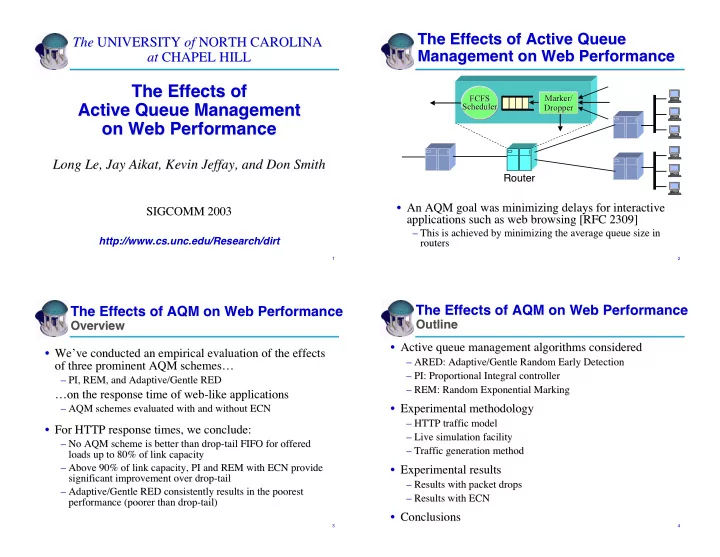

The Effects of Active Queue The Effects of Active Queue The UNIVERSITY The UNIVERSITY of of NORTH CAROLINA NORTH CAROLINA Management on Web Performance Management on Web Performance at at CHAPEL HILL CHAPEL HILL The Effects of The Effects of Marker/ FCFS FCFS Marker/ Scheduler Scheduler Dropper Dropper Active Queue Management Active Queue Management on Web Performance on Web Performance Long Le, Jay Aikat, Kevin Jeffay, and Don Smith Long Le, Jay Aikat, Kevin Jeffay, and Don Smith Router Router • • An AQM goal was minimizing delays for interactive An AQM goal was minimizing delays for interactive SIGCOMM SIGCOMM 2003 2003 applications such as web browsing [RFC 2309] applications such as web browsing [RFC 2309] – This is achieved by minimizing the average queue size in This is achieved by minimizing the average queue size in – http://www.cs.unc.edu/Research/dirt routers routers 1 1 2 2 The Effects of AQM on Web Performance The Effects of AQM on Web Performance The Effects of AQM on Web Performance The Effects of AQM on Web Performance Outline Outline Overview Overview • Active queue management algorithms considered Active queue management algorithms considered • • • We We’ ’ve conducted an empirical evaluation of the effects ve conducted an empirical evaluation of the effects – ARED: Adaptive/Gentle Random Early Detection ARED: Adaptive/Gentle Random Early Detection – of three prominent AQM schemes… … of three prominent AQM schemes – PI: Proportional Integral controller – PI: Proportional Integral controller – PI, REM, and Adaptive/Gentle RED PI, REM, and Adaptive/Gentle RED – – REM: Random Exponential Marking – REM: Random Exponential Marking …on the response time of web-like applications … on the response time of web-like applications • Experimental methodology Experimental methodology – AQM schemes evaluated with and without ECN – AQM schemes evaluated with and without ECN • – HTTP traffic model – HTTP traffic model • For HTTP response times, we conclude: • For HTTP response times, we conclude: – Live simulation facility – Live simulation facility – No AQM scheme is better than drop-tail FIFO for offered No AQM scheme is better than drop-tail FIFO for offered – – Traffic generation method Traffic generation method – loads up to 80% of link capacity loads up to 80% of link capacity – Above 90% of link capacity, PI and REM with ECN provide – Above 90% of link capacity, PI and REM with ECN provide • Experimental results • Experimental results significant improvement over drop-tail significant improvement over drop-tail – Results with packet drops Results with packet drops – – Adaptive/Gentle RED consistently results in the poorest – Adaptive/Gentle RED consistently results in the poorest – Results with ECN Results with ECN – performance (poorer than drop-tail) performance (poorer than drop-tail) • Conclusions • Conclusions 3 3 4 4
AQM Algorithms Considered AQM Algorithms Considered AQM Algorithms Considered AQM Algorithms Considered The original RED Algorithm The original RED Algorithm Adaptive/Gentle RED (ARED) Adaptive/Gentle RED (ARED) Mark/Drop Mark/Drop Router queue length Router queue length Router queue length Router queue length Mark/Drop Mark/Drop Probability Probability probability Max Max Max Max probability queue length queue length queue length queue length Weighted average queue length Weighted average queue length Forced drop Forced drop Forced drop Forced drop 2 2 × × Max Max Max threshold threshold Probabilistic Max Probabilistic “gentle gentle” ” drop drop threshold threshold “ Probabilistic Probabilistic Max Max early mark/drop early mark/drop threshold threshold Probabilistic Probabilistic Min Min early mark/drop early mark/drop Min Min threshold threshold No mark/drop No mark/drop threshold threshold No mark/drop No mark/drop Time Time Time Time Mark/Drop probability Mark/Drop probability Mark/Drop Probability Mark/Drop Probability 100% 100% 100% 100% Weighted Weighted max p max p Weighted Weighted Average Average max p max p Average Average Queue Queue min th min max th max Queue Length Queue Length min th max th 2 × 2 × max max th Length Length min max th th th th th 5 5 6 6 Control Theoretic AQM Control Theoretic AQM Control Theoretic AQM Control Theoretic AQM The Proportional Integral (PI) controller Random Exponential Marking (REM) The Proportional Integral (PI) controller Random Exponential Marking (REM) Router queue length Router queue length Router queue length Router queue length Target Target Target Target Queue Queue Queue Queue Reference Reference Reference Reference ( q ref ) ( q ref ) Time Time Time Time • REM is similar to PI (though differs in details) • REM is similar to PI (though differs in details) • PI attempts to maintain an explicit target queue length • PI attempts to maintain an explicit target queue length • REM mark/drop probability depends on: • REM mark/drop probability depends on: • PI samples instantaneous queue length at fixed intervals PI samples instantaneous queue length at fixed intervals • – Difference between input and output rate – Difference between input and output rate k th th and computes a mark/drop probability at k sample: sample: and computes a mark/drop probability at – Difference between instantaneous queue length and target Difference between instantaneous queue length and target – – p ( kT ) = a × ( q ( kT ) – q ref ) – b × ( q (( k -1) T ) - q ref ) + p (( k -1) T ) – p ( t ) = p ( t –1) + γ [ α ( q ( t ) – q ref )) + x ( t ) – c ] – a a , , b b , and , and T T depend on link capacity, maximum RTT and the depend on link capacity, maximum RTT and the – – prob ( t ) = 1 – φ -p ( t ) , φ > 1 a constant number of flows at a router number of flows at a router 7 7 8 8
Recommend
More recommend